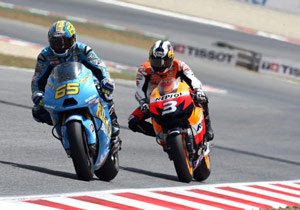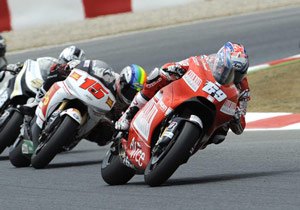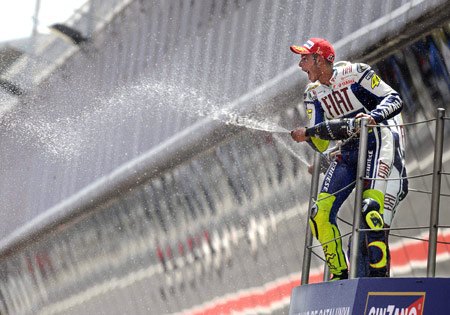You’ve probably heard the phrase, the battle is won but the war isn’t over. That little saying certainly could apply in the case of our 2009 Supersport Shootout. After assembling the current crop of middleweight supersport weaponry from the Big Four earlier this year, Kawasaki’s new-for-09 ZX-6R found itself atop the heap in our annual battle. It wasn’t an easy victory for the Kawasaki, as all the bikes in this class are excellent machines, separated by razor-thin margins in just about every respect. But in the end the ZX had just enough ingredients in the right combination to edge out the CBR600RR, GSX-R600 and R6.
Through the fault of no one, we weren’t able to get our paws on a 2009 Triumph Daytona 675 in time to join the Shootout, but recently we took possession of one; it’s time to rattle the ZX’s cage.
The 675 received its first updates since its debut in 2006, so the all-new 600cc Ninja had a serious title-defending fight on its hands. With its class-leading claimed 126hp (up 3hp for ’09) in-line Triple, improved brakes and springy parts, lighter weight and sharpened styling, the Trumpet has no intention of handing over the title on a silver platter.
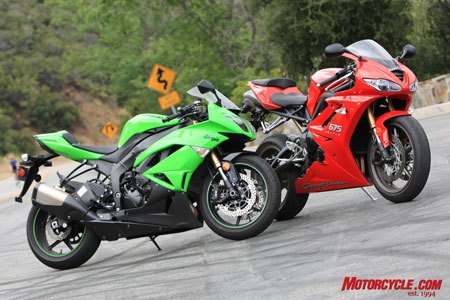 |
| New-for-09 Daytona 675! |
| We’ve covered the all-new middleweight Ninja in exhausting detail over several stories this year (see the list of Related Reading links at the bottom of this story) so let’s focus on some of the updates to the Triumph. With “almost a hundred technical updates,” Triumph proclaims the ’09 model as a lighter, faster and better-stopping bike than the first generation. In addition to new high- and low-speed damping control for the fully adjustable fork and shock, the other big news is some weight loss and a bump in peak horsepower. 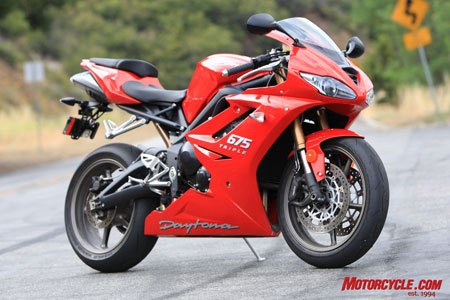 | | Here’s a brief list of improvements to the Trumpet: | | • 3hp power increase to 126 hp | | • Max redline increased by 450 rpm up to 13,950 rpm | | • Hydraulic cam chain tensioner from race kit now standard | | • Revised cylinder head with new valves & modified combustion chamber | | • Recalibrated EFI system to improve engine braking and decrease wheel chatter | | • Total of 6.6 lbs weight saving, now a claimed 357 lbs | | • New Nissin mono-block radial brake calipers & new brake rotors | | • Higher ratio first gear from race kit now standard | | • New rear wheel and rear wheel sprocket is combined 2.4 lbs lighter for less rotating mass | | • New exhaust system is 4.4 lbs lighter than previous model | | • New magnesium cam covers | | • Black painted engine cases | At first glance from across a crowded parking lot, the new 675 is nearly indiscernible from previous model years. However, it has a taller windscreen, and as our European partner-in-motocrime, Tor Sagen, informed us from the Daytona’s world press launch this year, the “front end has been redesigned slightly to match the original rendition of the designers.” |
In our 2008 Supersport Shootout we lauded the Triple mill for all the characteristics that make it such a great street motor, specifically linear, tractable power. We liked the 675’s engine so much it took top spot in the Engine category by a healthy margin, even beating out last year’s shootout overall winner, the CBR600RR. Our appetites were whet for the new Triumph in anticipation of even more claimed giddy-up and go!
This year Kawasaki would have no more of being pointed out as a bottom-feeder in the power category, so the ZX engine received one helluva going over. It put some serious hurt on the Big Four during dyno time, posting 107.7 hp, a full 10-point jump from 2008, and a solid 5 hp more than the next most powerful 2009 GSX-R600.
With roughly an extra 75cc of cylinder space, the Daytona appears still to have an unfair advantage. But even with a claimed additional 3-hp gain for the Brit bike, the Ninja has all but closed the power gap entirely on the Triumph. Dyno results for the Triumph as measured on the Mickey Cohen Motorsports dyno show a peak rear-wheel horsepower reading of 108.4 hp, which is a hair more than the ZX.
Proving grounds
Shuffling our usual order, we opted to go to Auto Club Speedway in Fontana, CA, first before conducting our street ride. It was here, thanks to our buddies at Fastrack Riders trackday company, that we got our first taste of the new Triumph and how its revised in-line Triple would fare against the Ninja’s in-line Four.
Too often riders get up hung up on final spec sheet figures, failing to realize it’s not just about peak pony and torque numbers. There are plenty of other things to factor in, like gearing for example, to get a fuller picture of a bike’s power development. “A much taller low gear works great on the track to close up the ratios,” Kevin “MotoGT” Duke said of the Daytona. But he was quick to point out that in street settings the tall first gear seemed to “blunt some of the strong acceleration of the previous version when leaving stop lights.”
Something else we observed over the course of a full trackday with longer-than-usual ride sessions was the Triumph’s deceptive speed. The Daytona doesn’t rev as high (just under 14K vs. 16.5K rpm), or quite as manically as the Ninja, nevertheless it hangs tight with the Ninja. “Power is so linear it doesn’t feel superfast,” Kevin said of the smooth Triple.
The green bike on the other hand is a true supersport screamer, as it develops more power in the upper rpm range. We also noted its improved midrange this year is significant enough that you can be a bit lazy, running a gear higher than you might normally select for some corners. A good and welcome improvement over the 2008 ZX-6R, but the green assassin can’t quite match the Trumpet's strong pull out of slow corners.
Lap times at a public trackday usually don’t give a fully accurate indication of which bike is quicker, as clean laps are hard to come by thanks to red-flag stoppages, or clusters of riders of varying speeds bunched up right where you don’t need them. Yet, with timing transponders as part of the trackday package with Fastrack we were able to gather enough consistent lap times to see that neither bike suffered an appreciable deficit to the other.
Over the course of the entire day, my best time was aboard the Ninja, beating out the 675 by exactly 1.0 second. However, by and large, times recorded for my sessions often showed less than a second between the bikes. Early on, Kevin’s times showed bigger gaps between each bike, but by day’s end he had each bike in a neck-and-neck duel. While aboard the Triumph he edged out his best time on the Ninja by a mere 0.003 of a second. He also pointed out that though the ZX's Bridgestone BT016 tires are excellent, “the Daytona's Pirelli Supercorsa rubber offered at least as much grip and lasted longer during our track sessions,” providing some insight for the Triumph’s slight edge.
Another item we caught wind of was the smoother transmission in the Ninja; the 675 was more resistant to clutchless upshifts and generally “notchier,” according to Kevin.
| No slipper, no problem |
| Of the five bikes in the supersport realm, only two do not have a back-torque-limiting clutch: the Honda CBR600RR and Triumph Daytona 675. 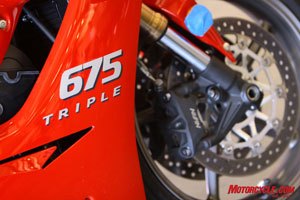
Even after a second-generation update, the 675 still lacks a traditional slipper clutch, but the Hinckley-based company has found a creative way to quell some of the rear-wheel hop and clutch chatter that comes as the result of racer-boy rapid-fire downshifts. We had an opportunity to chat with Triumph’s Product Manager Simon Warburton, to get a better understanding of how engineers chose to mitigate, at least partially, some of the unwelcome forces that can upset a bike’s chassis following bang-bang-bang downshifts. According to Warburton, the Keihin fuel injection system lifts a throttle plate to reduce engine compression braking, feeling a little like it has a slipper clutch. He reminds us that the system was present on the previous Daytona but got fine-tuned for the ’09 update to further decrease wheel chatter. A cost-saving method if not rather inventive. |
Aside from the welcome power increase, perhaps no bigger news came with the Ninja than being one of the first production bikes to use Showa’s Big Piston Fork, aka BPF. The simple but highly effective fork impressed us during the Supersport Shootout for its ability to absorb small surface imperfections without suffering as an overly soft set-up. But here, too, the 675 has its bases covered. Upgraded suspension adjustability allowed us to fine-tune the fork on the Daytona to the point that any differences in front-end feedback or bump absorption between the bikes were negligible; same story for shock compliance.
In terms of overall handling prowess, it’s another situation of tit-for-tat. The slender, narrow-waisted Trumpet not only looks light and flickable, it is. Tip-in is slightly sharper, as it boasts racier steering geometry: 23.5-degree rake, 87mm trail, 54.8-inch wheelbase vs. 24.0-degree rake, 103mm trail, 55.1-inch wheelbase.
Despite it’s milder steering geometry the Ninja still manages to shake its head more often under hard acceleration than the Triumph did. This quality isn’t necessarily a problem, and rather entertaining if you’ve the right mentality for it, but it leads us to think that maybe next year Kawasaki should provide some extra resistance in the manually adjusted Ohlins steering damper or opt for some sort of electronically controlled speed-sensitive unit like on the Honda or Suzuki.
The ZX-6R dominated all comers when it came time to reel in the incredible speed these modern sportbikes generate. No bike could come close to the absolutely sublime combination of power and sensitivity the Ninja’s four-pot, radial-mount, mono-block Nissin calipers offer. The Triumph’s new-and-improved Nissin radial-mount mono-blocks are a good update from last year, providing plenty of power and less lever travel before engagement compared to the ’08 model. However, they’re a click or two off the Kawasaki in terms of outright best feel.
We’ve said it once or twice, or maybe a thousand times before, but the street scene is where the lion’s share of supersport motorcycles purchased in the U.S. will see action. With this reality in mind, ergos, instrumentation, and fit and finish go along way.
The 675’s more aggressive riding position and firm saddle might make some folks (creaky boned old geezers for example) think twice before considering the Triumph as a sport-tourer or long-distance daily commuter. The forward-canted riding position, courtesy of low placement of the clip-ons, is great for the racetrack but tough on wrists Monday through Friday. The Kawi has a marginally lower seat height (32.1 vs. 32.5 inches), but more importantly its shape and foam density are more welcoming of longer days in the saddle. Also, the ZX’s rider triangle isn’t tilted as forward as the Triumph’s. Additionally, Kevin noticed that he couldn’t see directly behind himself through the Triumph’s mirrors.
Both bikes have well-thought-out instrument packages. A large, clear LCD panel sits next to prominently displayed tachometers, but the choice of a white face on the Kawi’s tach makes it that much easier to see. The 675 gets bonus points for having additional available info like average fuel economy and top-speed storage (don't show the fuzz...), but the settings aren't intuitive to figure out without the manual.
Ah, hell, who cares about anything other than peak horsepower and looks, right? If that’s the case the Daytona has at least one department easily squared away. In our book, the Ninja’s angular, almost cubist form, can’t compare to the wicked, intimidating face on the 675. Fire the starter, blip the throttle or get the engine on full song, and the exquisite intake snort and exhaust note from the Triple make you say, “Fugedaboudit!”
Photo-finish face-off
Anyone paying attention the past three years or so knows this class of bikes is a coin-toss. True, the Kawi made serious strides in peak horsepower, and as we noted in our fuller supersport comparison the Honda and Yamaha took a step back in peak power (See sidebar in 2009 Supersport Shootout), but you could make a case for any of ‘em, including the Triumph. However, the salient point to take away from this Japan vs. Britain face-off is that the Kawi’s as quick and powerful as the Triumph, but does so without the benefit of additional displacement.
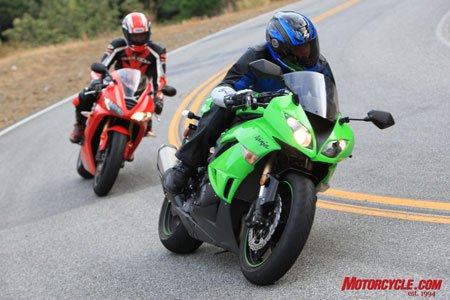 |
Furthermore, it weighs about the same (claimed dry 394 lbs to the Triumph’s 392 lbs), is a little more comfortable in everyday use, and has unmatched braking performance. Best of all, you won’t pay a penny more to get the extra performance from the Ninja. Both bikes retail for $9,799. Still, the ZX simply doesn’t have the Triumph’s sex appeal. And owning the British-made bike brings a degree of exclusivity; we just don’t see as many Daytonas on the street (or track for that matter!) as Ninjas.
So, to put an end once and for all to the 2009 600cc battle, we give a final nod to the Kawasaki. But the real winner in all this is you, modern-day supersport consumer!
| Here's how I see it... |
| The ZX does pretty much everything right and absolutely nothing bad. It's a ripper on the track and most hospitable on the street, with much friendlier ergos and long-haul comfort, not to mention best-in-class suspension, brakes and slipper clutch. But the Triumph has an ace in the hole with one of our favorite street engines of all time, providing big-time midrange punch accompanied by a THX-level soundtrack. Plus it looks sexier. It's also quite remarkable that two exemplary machines with disparate specifications and countries of origin sticker at identical MSRPs. We can't blame you for picking one over the other. --Kevin “MotoGT” Duke The Kawasaki’s overall performance package is undeniable, and I applaud Team Green for coming back so strong after a couple years of not-so-great results in magazine shootouts. Still, if I were the average sportbike customer (mostly street rides, occasional track day, if at all) I’d be drawn to the Daytona, despite its edgier ergos. I love the “mechanical symphony,” as Kevin calls the exhaust and intake notes. I find the slender lines and airiness makes the 675 look faster; the front end is infinitely tougher looking, too. I’d be a little bummed about not having the ZX’s incredible brakes, but in all other aspects the Daytona works quite well. Pip pip, cheerio and all that rot! --Pete “Boddingtons Pub Ale” Brissette |


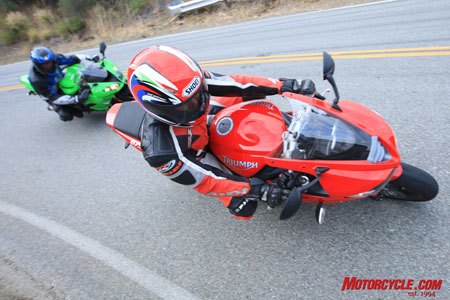
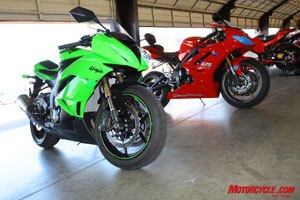
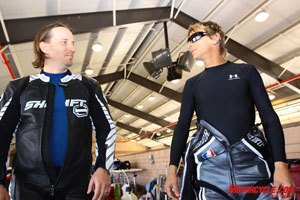

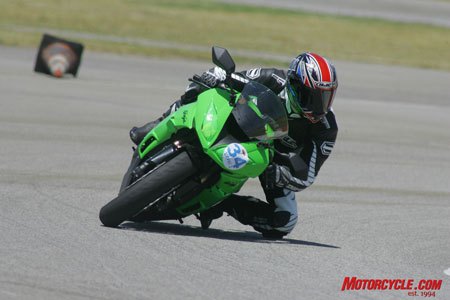
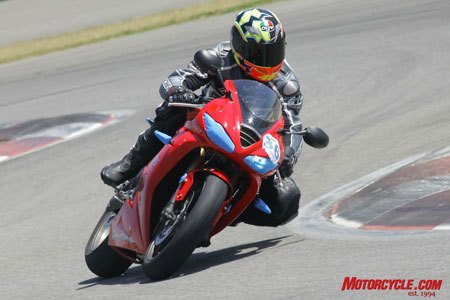
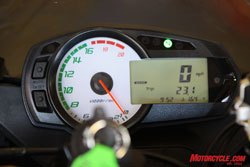


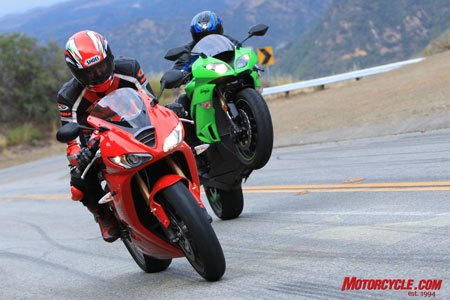
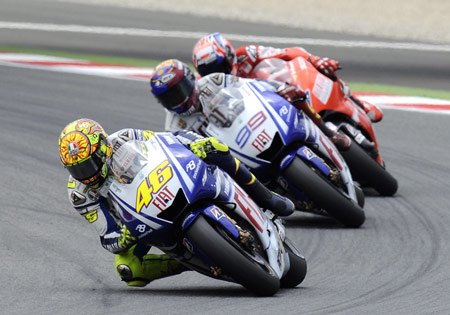
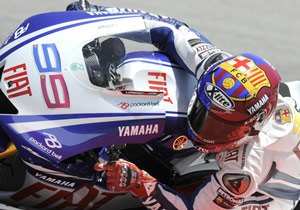 Aside from winning his 99th race, setting the table for #100 in Assen a week from Saturday, the win had to be especially gratifying for Rossi. Lorenzo has challenged Rossi more than any teammate he’s ever had. The young Spaniard was a heavy crowd favorite on Sunday, wearing a helmet in salute to the Barcelona soccer club that had won the European Cup championship in Rome last month. And Sunday’s papers had been full of stories from the Italian press suggesting that, at age 30, Rossi was over the hill. As the race announcers observed immediately after the race concluded, “Write him off at your peril.” And although Jorge Lorenzo may one day displace Valentino Rossi from his perch atop the world of international motorcycle racing, that day will have to wait awhile longer.
Aside from winning his 99th race, setting the table for #100 in Assen a week from Saturday, the win had to be especially gratifying for Rossi. Lorenzo has challenged Rossi more than any teammate he’s ever had. The young Spaniard was a heavy crowd favorite on Sunday, wearing a helmet in salute to the Barcelona soccer club that had won the European Cup championship in Rome last month. And Sunday’s papers had been full of stories from the Italian press suggesting that, at age 30, Rossi was over the hill. As the race announcers observed immediately after the race concluded, “Write him off at your peril.” And although Jorge Lorenzo may one day displace Valentino Rossi from his perch atop the world of international motorcycle racing, that day will have to wait awhile longer.